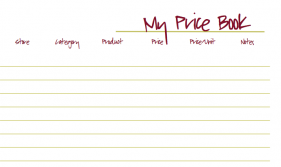 Lately, I’ve received a lot of questions from readers such as:
Lately, I’ve received a lot of questions from readers such as:
How much do you aim to pay for paper towel?
I found this sale on napkins. Is it a good deal?
What’s the best price on apples/oranges/pineapple/lettuce/insert-the-produce-item?
What’s a good deal on diapers?
I’ve even had readers ask me point blank to send them my personal price book.
While I’m happy to help you figure out how to calculate a great deal for YOU, I won’t be sharing my personal price book here on KOAB. And here’s why:
#1. My price book is based on the prices of items in Kansas City. I pay more for produce that my friends in California, but less for shelf-stable items like cereal. Prices on food (and everything else for that matter) vary regionally, and as such – my “buy now” price will likely be different than yours.
#2. I’ve been couponing and stockpiling for over three years. I’ve got a deep stockpile of everything from paper towels to Bar-B-Que sauce to baby wipes. If you NEED paper towel right NOW, then odds are you will pay more for it than someone who has three month’s worth in their stockpile.
A stockpile is the best insurance policy against overpaying – but you can’t build one up over night. It takes time and patience to get the best deals, in bulk. Once you get there, your “buy now” price will drop – because you can “afford” to wait on the next deal-of-the-century on paper towel. Until then, you need to do the best you can.
#3. I live in a house in the suburbs with ample storage room in my basement. Apropos to point #2, I can acquire, store and organize a “deeper” stockpile than someone in an urban apartment. I might rather run to Target to get a great deal, while someone else is willing to pay a bit of a premium on having products delivered via Amazon. (The truth is that I hate shopping in stores, and I therefore DO prefer to buy as much as possible from online stores like Amazon. But that just illustrates why my price book may look different than yours.)
#4. I am not brand-loyal about very many products. We mostly use cloth rags, so the paper towel we have in our stockpile is primarily for dog-related ickies. I could care less if it’s Sparkle or Viva or Bounty. My “buy now” target is based on the very lowest per roll price I can buy, period. Some of you really like your Bounty, or Charmin or Tide… or whatever – and are willing to pay a premium for it.
There’s no right or wrong answer to brand loyalty – as long as you can “afford” that premium. But again, the price book of a brand-loyal consumer looks different than the one of someone who isn’t brand loyal.
#5. We don’t have food allergies or sensitivities. I can buy regular flour, eggs, dairy, nuts, etc. No special gluten-free, nut-free, egg-free ingredients required. Therefore my price book is based on — again — the lowest price point I can get for these various items. If you need gluten-free baking ingredients, my price book wouldn’t be much help. But YOUR price book would be!
And that is why I strongly encourage each and every family to start and maintain their OWN price book. If you want to cut your grocery bills, your price book will be your #1 tool in becoming a savvier shopper.
{I get why readers ask to see my price-book – it’s a short-cut. But my price book isn’t going to help you long-term. It may not even help you short-term. I’m all about teaching you to fish, not giving you a fish!}
Here’s my Price Book 101 Tutorial, complete with free printables and a free Excel chart to help you track your data.
Good luck – and let me know if you have any questions about getting started with your price book.















Do you know of any price book apps? I really, really hate paper. 🙂
Create one and make millions! 🙂
Or I would write them out and scan it, or have it on an excell and saved on your phone (from an email) to access through adobe or kindle free apps.